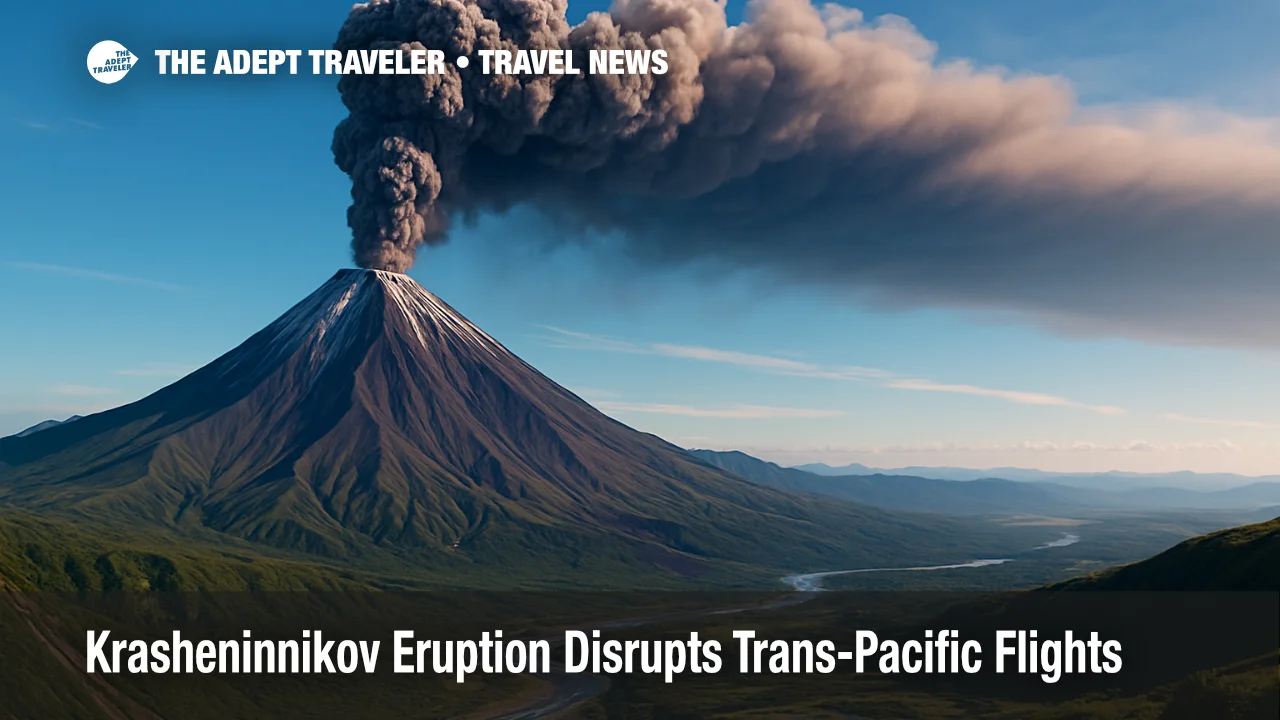Krasheninnikov Eruption Disrupts Trans-Pacific Flights

A sudden blast from the long-dormant Krasheninnikov volcano on Russia's Kamchatka Peninsula has upended summer travel across the North Pacific. Ash plumes climbing to roughly 28,000 ft drifted east on prevailing winds, intersecting great-circle flight paths between Japan and Alaska. The Kamchatka Volcanic Eruption Response Team has kept the aviation color code at orange, and Russia's emergency ministry says additional explosive pulses are possible. Airlines are tracking Tokyo VAAC updates every six hours, while cruise operators scheduled to visit Petropavlovsk-Kamchatsky weigh itinerary changes for passenger safety. Travelers crossing the region this week should prepare for longer routings and late-breaking schedule tweaks.
Key Points
- Why it matters: Ash can stall jet engines and pit windscreens, making avoidance mandatory.
- Travel impact: Flights are adding up to 45 minutes and extra fuel to skirt the cloud.
- What's next: Cruise lines will decide within days whether to skip Petropavlovsk calls.
- Contingency: U.S.-Asia freighters may shift to polar tracks via Anchorage.
- Safety tip: Monitor carrier apps and opt into push alerts for gate or timing changes.
Snapshot
Tokyo VAAC imagery shows a diffuse but persistent ash veil stretching 620 mi east-southeast of the crater. At 06:20 UTC, the core plume remained above FL260, outside the climb paths of narrow-body jets but squarely across the NOPAC tracks favored by wide-bodies linking Tokyo Haneda International Airport (HND) and Ted Stevens Anchorage International Airport (ANC). Meteorologists expect high-level winds to keep steering the cloud toward the Gulf of Alaska through Thursday; shear should thin concentrations, yet operators will maintain conservative buffers until a full dispersal forecast is confirmed.
Background
Krasheninnikov, a 6,089-ft twin-caldera shield stratovolcano 125 mi northeast of Petropavlovsk-Kamchatsky, last erupted in the fifteenth century. Its 2025 awakening followed a magnitude-8.8 offshore earthquake on July 30 that unsettled crustal stress along the Kuril-Kamchatka trench. Scientists from Russia's Institute of Volcanology reported rapid magma ascent and ground inflation in the days before the blast. The first ash column reached 19,700 ft, quickly intensifying to today's 28,000 ft plume. While no settlements lie downwind, the peninsula's rugged topography funnels ash directly over some of the planet's busiest trans-Pacific lanes, echoing the 2010 Eyjafjallajökull scenario that grounded European airspace.
Latest Developments
Airlines Shift Great-Circle Routes Southward
Major Japanese, Korean, and U.S. carriers have filed NOTAMs indicating temporary closure of NOPAC Routes 1-4. Flight-tracking data show several Tokyo-Seattle and Seoul-Los Angeles services dipping 300 mi south of their usual tracks, inflating block times by 25-45 minutes and adding fuel burn. Cargo operators Atlas Air and Nippon Cargo have rerouted freighters through Anchorage for tech stops and crew swaps. Travelers should anticipate higher load factors on remaining seats and arrive early, as gate assignments at HND and ANC may shuffle to balance on-time performance. The International Air Transport Association's volcanic-ash toolkit offers real-time graphical layers for route planning (https://www.iata.org/ash-toolkit?utm_source=adept.travel).
Cruise Operators Review Petropavlovsk Calls
Expedition brands including Holland America Line and Silversea have late-August calls booked at Petropavlovsk-Kamchatsky. Local agents tell Travel and Tour World that cruise managers are "closely monitoring VAAC bulletins" and preparing contingencies such as Kodiak or Dutch Harbor swaps if ashfalls threaten port operations or scenic cruising. Passengers on 28-day "Volcanoes & Glaciers" itineraries will receive final port-order confirmations 72 hours before sailing. Those with independent shore tours should hold refundable reservations and maintain open communication channels with ship staff.
Analysis
Volcanic ash presents a uniquely complex hazard. Microscopic silica particles can melt inside turbine engines, fusing onto compressor blades and starving combustion chambers of airflow, as documented on KLM 867 over Alaska in 1989. Modern satellite detection and VAAC coordination greatly reduce surprise encounters, yet reroutes carry cascading effects: longer flight times strain crew-duty windows, boost fuel burn, and tighten aircraft rotations worldwide. Airlines often pass incremental costs to travelers via fuel surcharges or dynamic pricing. For cruise lines, Kamchatka is a marquee destination offering geothermal parks and brown-bear viewing; cancelling a call can disappoint high-yield adventure guests, but a single ashfall can immobilize deck equipment and degrade hull coatings. Insurance policies typically treat volcanic disruption like severe weather-traveler-initiated cancellations seldom qualify for cash refunds unless "extreme events" wording appears. Therefore, flexible fares and third-party "cancel for any reason" coverage remain prudent. This eruption also underscores the broader vulnerability of Arctic and sub-Arctic routes: as polar traffic grows, so does exposure to high-latitude geohazards, demanding resilient network planning and cross-industry coordination.
Final Thoughts
Whether you are a mileage-runner chasing cheap Asia fares or an expedition enthusiast eyeing Kamchatka's remote beauty, the Krasheninnikov volcano reminds us that nature still governs the timetables. Keep itineraries fluid, invest in coverage, and monitor official bulletins until the ash cloud fully dissipates.
